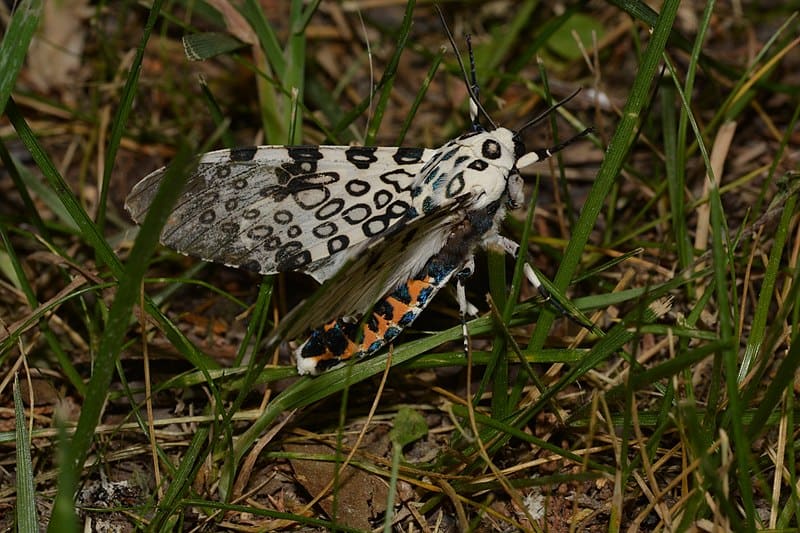Giant Leopard Moth Facts
- Perhaps most worthy of note’s the fact that the Giant Leopard Moth lives up to its name. That’s due to the fact that this magnificent Lepidoptera ranks as one of the largest in its native range. Its beauty and size, therefore both serve to impress.
- Professional researchers, however, know it by its scientific name. That term, though, remains somewhat hard to pronounce. More precisely, its official name on scientific records is that of the Hypercompe scribonia. A true tongue-twister, indeed.
- This insect further owes its scientific recognition as a separate species to a lesser-known individual. That less well known, but nonetheless respectable, researcher, was a Dutch naturalist. His acknowledgement of the species occurred in 1790.
- For the moment, the amazing Giant Leopard Moth stands out for yet another reason. That’s because it seems to be maintaining a stable and sufficient population base. That fortunate fact also appears to hold true throughout the entirety of its natural range.
- The IUCN, therefore, currently lists this remarkable invertebrate as Least Concern. This surprising status appears on the organizations’ Red List of Threatened Species. That status alone distinguishes the creature from a large percentage of its peers.
- The Lepidoptera nevertheless still faces various threats to its continued existence as a species, though. The danger of habitat loss remains a great danger to it, of course. Its greatest threat, however, comes from the ongoing effects of climate change.
Related Articles
CCL: http://bit.ly/2zBWbKi
Giant Leopard Moth Physical Description
The incredible Giant Leopard Moth clearly merits attention due to its sheer size, quite obviously. The insect also displays a moderate degree of the physiological characteristic of sexual dimorphism. It does so, however, in a very specific, and somewhat unusual manner.
Both genders of the astounding insect, firstly, attain an average wingspan of about 3 in (7.6 cm). That measurement alone distinguishes it from most other known Lepidoptera. The gender-based differences, though, manifest themselves in terms of overall length.
Males of the surprising species generally reach a length equaling about 2 in (5.1 cm). Females, though, achieve a much smaller average length. More precisely, in fact, these rarely exceed a body length of around 1.2 in (3 cm). This represents a relatively extreme difference.
The wings of the creatures, though, generally present the same general appearance. These usually present a bright white background, covered in a pattern of black blotches. Some of these are solid, yet some are hollow. Also, a few blue blotches often appear on the heads.
In contrast, the abdomen of the Giant Leopard Moth shows as significantly different. This part of the body shows bright colors. These usually include dark blue with orange markings for the abdomen. Males, however, often have a thin yellow line on the side of the body.
- Kingdom: Animalia
- Phylum: Euarthropoda
- Class: Insecta
- Order: Lepidoptera
- Family: Erebidae
- Genus: Hypercompe
- Species: H. scribonia
Giant Leopard Moth Distribution, Habitat, and Ecology
Yet another fact about the stunning Giant Leopard Moth separates it from the pack, so to speak. That’s its native range. This holds true due to the fact that this magnificent insect actually inhabits quite an extensive range. That zone of habitation remains specific, however.
It lives across a wide swathe of the Northern Hemisphere. More exactly, it primarily exists in a thin area of North America. This runs from Ontario, Canada, through the southern and eastern United States. Scattered populations also exist all the way to Panama.
In addition, it also displays decided habitat preferences. As a result, it prefers to inhabit various forest regions with host plants for caterpillars. It will, however, often inhabit woodlands, farmlands, gardens, and even public areas, opportunistically.
In its caterpillar stage, it feeds on a wide variety of host plants possessing broad leaves. These usually include honeysuckles, citrus, violets, magnolias, lilacs, and dandelions. The wonder of nature also feeds quite voraciously at this time, making it a pest to some people.
Fortunately, the Giant Leopard Moth has one more factor working in its favor. That’s the fact that this beautiful moth has very few natural predators. This holds true because both the spiny texture of its fur and the coloring of its wings dissuade most predators.
It’s also known for a distinctive trait. It often has protracted mating sessions, sometimes lasting for as much as 24 hours. Unlike many related species, its caterpillar stage does not sting. Its defensive measures usually only extend to rolling into a protective ball.
It does occasionally release a liquid in self-defense, however. This, emitted in small droplets, is a yellowish fluid which is harmless to humans. In this way, Nature provided this otherwise harmless beauty with the ability to defend itself quite effectively against threats.
Species Sharing Its Range
Check out our other articles on 10 Remarkable Rare Cetaceans, Wolfsbane, Mexican Mole Lizard, Giant Crystal Cave, Pacific Sea Nettle, Scottish Wildcat, Hyacinth Macaw, Texas Alligator Lizard

